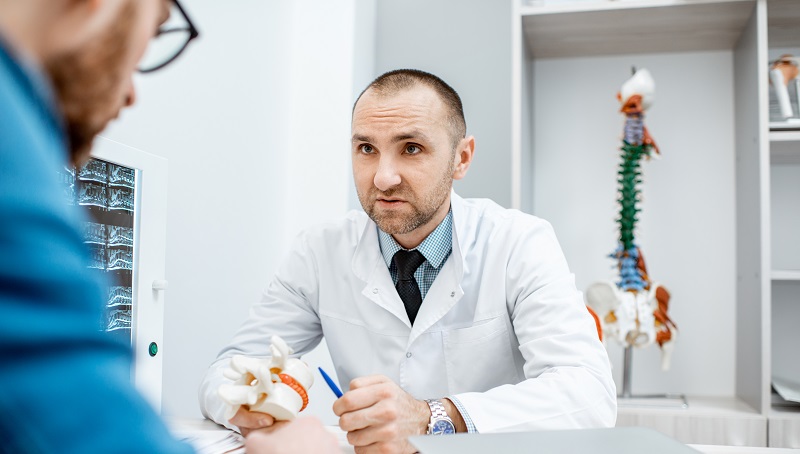Insights on understanding herniated discs
Back pain is a major problem among Americans. It’s the sixth leading most costly condition in the U.S. with about 8 percent of all adults having persistent back pain limiting their ability to work or perform daily activities.
One type of back pain many people suffer from is called a slipped or herniated disc. There are 24 bones called vertebrae that make up the human spine. Some of the vertebrae are cushioned by soft discs allowing us to bend over and do movements like twisting our body side to side. But if a disc between two vertebrae slips out of place, nerves surrounding this area become irritated causing severe pain known as a slipped or herniated disc.
The location of a most herniated disc is in the lower back which can irritate nearby nerves resulting in pain, weakness, or numbness in an arm or leg. If the pain is in the leg, it may extend down to your leg, ankle, or foot. You may also lose some feeling or have tingling or weakness in your legs. However, some people with a herniated disc have no pain. Usually, most people with a herniated disc do not require surgery to fix the problem.
To further understand and become familiar with herniated discs, here are facts helping you assess if you have a herniated disc, getting treated and how they may be prevented:
Who is more at risk for herniated discs?
Various factors can increase your risk of developing a herniated disc. One factor is getting older. The spine contains a lot of water. With aging, discs become weaker and drier, a process called disc degeneration. The discs can also shrink causing the bones in your spine to get closer together.
Another factor is excess weight gain which adds additional stress on the lower back. Also, using the poor technique when lifting a heavy object, along with constant twisting or bending, can irritate discs leading to herniation.
Signs of a herniated disc
While herniated discs can occur in any part of the spine, the lower back (the lumbar spine), just above the hips, is the most common location. Sometimes this pain may even spread from the back to the buttocks, thighs, and calves.
Activity tends to increase the pain of a herniated disc, and for some, even coughing or sneezing puts pressure on pinched nerves.
Getting diagnosed for a herniated disc
If you are experiencing symptoms associated with a herniated disc, see your doctor. Do not self-diagnosis. A physical exam is crucial for diagnosing the location and source of pain of a herniated disc. The exam may include a neurological check which includes checking for signs of loss of sensations such as numbness or weakness in a leg or foot. Muscle strength and reflexes will also be checked.
You may be asked to lean forward and back and bend from side to side to assess your range of motion. In addition, you may be asked to lie on your back and lift your legs in various positions checking for a herniated disc. The doctor will also observe your gait checking for difficulty in walking due to pain. Other health issues or habits will be discussed to assess their role in your back pain.
Sometimes, doctors will order a CT scan or MRI to diagnose a herniated disc to help confirm the diagnosis of a herniated disc.
How are herniated discs treated?
The primary goal of treatment is to relieve pain and other symptoms caused by the herniated disc. Treatment plans for this condition should be individualized based on the source of pain, the severity of pain, and the specific symptoms a patient is experiencing.
In general, doctors will recommend conservative treatment first. That might be a day or two of rest; however, it’s important to get up and start moving again as soon as possible. Prolonged bed rest can worsen back pain since changes can take place within spine that is not helpful for healing. Ask your doctor what physical activities you can do safely without compromising the health of your discs. Usually, they will recommend avoiding heavy lifting or strenuous activity.
A referral to a physical therapist (PT) can help. These trained professionals will perform specific exercises to improve core strength, flexibility, and endurance helping you engage in normal activities. PT’s will help you learn stretching exercises improving flexibility of tight muscles and have you do aerobic exercises such as walking or using a stationary bike, to build endurance and improve circulation.
Spinal injections, referred to as epidurals, may also be recommended to help reduce swelling and inflammation of the nerve roots.
Surgery is generally not needed, but if you continue to have weakness, trouble walking or the pain is not improving or getting worse, it may be an option. A thorough discussion with your doctor and an orthopedic surgeon going over the pros and cons of surgery for a herniated disc is necessary to make the best decision.
Reducing your risk of a herniated disc
This is the question to be asking before any sign of back problems begin. There are many lifestyle habits that help reduce your risk in preventing a herniated disc:
- Always use proper lifting techniques.
- Maintain a healthy weight as excess weight puts pressure on the lower back.
- Practice good posture when walking, sitting, standing, and sleeping.
- Stretch often when sitting for long periods of time.
- Avoid wearing high-heeled shoes.
- Exercise regularly keeping muscles of your back, legs, and stomach strong.
- Don’t smoke
- Eat healthy, well-balanced meals

